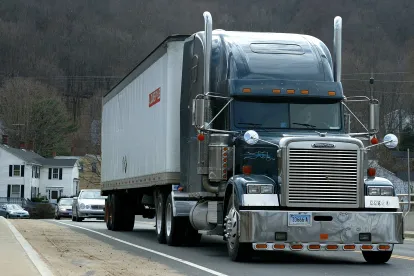This summer, California announced a plan that could significantly reshape all levels of the transportation industry from manufacturing and logistics to electric vehicle charging infrastructure. On June 25, 2020, the California Air Resources Board (CARB) unanimously approved the Advanced Clean Trucks Rule. The Rule requires truck manufacturers to ensure that some percentage of trucks sold in the state are zero-emission vehicles, with a target that by 2045, all new trucks sold in California must be zero-emission. The Rule also requires large employers to report information about shipments, shuttle services, and fleet operations. While California is the first state to mandate the sale of zero-emission trucks, other states have recently voiced support and soon may adopt similar rules, provided the Rule survives a legal challenge brought by a coalition of manufacturers of natural gas fueled vehicles.
An Ambitious Reshaping of Transportation
The Rule applies to all commercial trucks and vans sold in California including pickup trucks, delivery trucks, short-haul drayage trucks at ports and railroads, semi-trailer trucks, and big rigs.
Under the Rule, starting in 2024, truck manufacturers must sell a minimum number of zero-emission models in California. “Zero-emission” vehicles are vehicles that emit no criteria pollutants such as nitrogen oxides that are produced during combustion of a fuel. While CARB has identified hydrogen fuel cell vehicles as one type of “zero-emission” vehicle, in practice, CARB appears to assume that the majority of these vehicles will be electrified, not powered by hydrogen. This is notable, as on July 8, 2020 the European Union announced a long-term strategy to decarbonize that focuses on renewable hydrogen as a replacement fuel for numerous categories, including transportation.
The percentage of electric trucks that manufacturers must sell gradually increases each year under the Rule. By 2035, more than half of the trucks sold in California must be zero-emission. The following chart breaks down the percentage of vehicles, in each class, required to be zero-emission:
| Model Year | Class 2b-3 | Class 4-8 | Class 7-8 Tractor |
| 2024 | 5% | 9% | 5% |
| 2025 | 7% | 11% | 7% |
| 2026 | 10% | 13% | 10% |
| 2027 | 15% | 20% | 15% |
| 2028 | 20% | 30% | 20% |
| 2029 | 25% | 40% | 25% |
| 2030 | 30% | 50% | 30% |
| 2031 | 35% | 55% | 35% |
| 2032 | 40% | 60% | 40% |
| 2033 | 45% | 65% | 40% |
| 2034 | 50% | 70% | 40% |
| 2035 | 55% | 75% | 40% |
The Rule also requires manufacturers to report information to CARB regarding the sale of diesel and electric vehicles. Under the Rule, manufacturers can transfer, receive, and bank zero-emission credits. Starting in 2021, manufacturers may start generating credits, but all credits expire in 2031. The Rule also gives CARB the authority to audit manufacturer’s records, assess civil penalties for noncompliance, and publically disclose a manufacturer’s vehicle production and sales in California.
In conjunction with the Rule, CARB announced that it is considering two complementary regulations that will also target emissions. The first will set a new limit on NOx (oxides of nitrogen), one of the major precursors of ozone formation, requiring new diesel and gas truck manufacturers to design the vehicles to meet that low limit. CARB is also considering requiring larger fleets in the state to meet annual targets for a transition to zero emission vehicles.
However, before California can enforce the Rule (or the two complementary actions if adopted), the U.S. Environmental Protection Agency (EPA) must authorize a waiver of the otherwise applicable prohibition on states adopting their own emissions standards. Under Section 209 of the Clean Air Act, unless the EPA finds certain limited grounds for denial it must grant California a waiver of preemption. Until 2019, the EPA granted all of California’s waiver requests. However, the current administration withdrew California’s Clean Air Act waiver in 2019 to prevent CARB from enforcing another rule for light-duty vehicles. California and a coalition of 22 other states challenged the withdrawal, and the case is currently being litigated.
Other States Signal Support for California’s Rule
While California is the first and, for now, the only state to require zero-emission trucks, the new Rule will have a nationwide impact if the EPA grants California a Section 209 waiver. Other states are likely to follow California’s lead, as authorized under Section 177 of the Clean Air Act.
On July 14, 2020, fifteen states and the District of Columbia signed a nonbinding memorandum of understanding to develop an aggressive plan to lower carbon emissions by 2050. The states, working with an existing zero-emissions taskforce, aim to accelerate the market for medium and heavy-duty electric vehicles. The following states are participating in the initiative: California, Connecticut, Colorado, Hawaii, Maine, Maryland, Massachusetts, New Jersey, New York, North Carolina, Oregon, Pennsylvania, Rhode Island, Vermont, and Washington. Assuming the states follow through, it is likely these states will pass regulations adopting CARB’s zero-emission rule for trucks.
While the Rule plots an ambitious course for California and other states to follow, it must first survive a legal challenge filed in state court. On July 30, 2020, a coalition of manufacturers of natural gas fueled vehicles challenged the Rule in Fresno County Superior Court alleging violations of the California Environmental Quality Act (“CEQA”) and seeking an injunction barring enforcement of the Rule unless and until certain changes are made that would allow natural gas fueled vehicles as an additional mitigation option for heavy-duty transportation vehicles. While courts generally grant deference to the State when reviewing actions under CEQA, the outcome of the challenge remains to be seen.
Implications for the Transportation and Logistics Industries
The Rule proposes nothing less than a fundamental reshaping of the transportation fleet, supply chain, and support infrastructure. Electric trucks, like electric cars, utilize different components and different chassis than traditional vehicles, presenting both opportunities and challenges for suppliers. In addition to shifting sales of the truck markets in all states adopting the Rule, electric trucks will require long-lasting battery packs that can be swapped out when needed. The Rule will also intensify the demand for installation of electric charging infrastructure and supporting transmission along transport routes. Likewise, hydrogen-powered vehicles require a substantially different fuel storage system, and operate off of fuel cells that generate electricity, as opposed to combustion in a piston-driven drivetrain. They, too, will require new fueling stations, as well as a new bulk distribution system.
The Rule will also have implications for logistics providers and how transport is dispatched. While some states will adopt the Rule, others may not, for reasons that may include reliability concerns during severe cold weather outside of the operating range of current lithium-ion batteries. In addition, to succeed, adopting states will likely need to subsidize, at least initially, the installation of the charging infrastructure required for the transition.
It remains to be seen how the transition of the heavy-duty transport sector to zero-emission vehicles will occur, and whether and how states choose to participate in that transition. If electrification is the preferred approach, it may create a divergence between U.S. and European suppliers. Ideally, interested stakeholders should work with the regulatory community to develop workable proposals.
We'd like to thank Brittany Mefford, summer associate, for her contributions to this alert.





 />i
/>i

